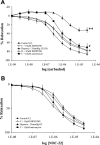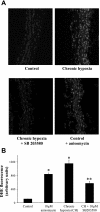Inhibition of p38 MAPK reverses hypoxia-induced pulmonary artery endothelial dysfunction
- PMID: 19201999
- PMCID: PMC2685327
- DOI: 10.1152/ajpheart.00977.2008
Inhibition of p38 MAPK reverses hypoxia-induced pulmonary artery endothelial dysfunction
Abstract
Hypoxia-induced endothelial dysfunction plays a crucial role in the pathogenesis of hypoxic pulmonary hypertension. p38 MAPK expression is increased in the pulmonary artery following hypoxic exposure. Recent evidence suggests that increased p38 MAPK activity is associated with endothelial dysfunction. However, the role of p38 MAPK activation in pulmonary artery endothelial dysfunction is not known. Sprague-Dawley rats were exposed to 2 wk hypobaric hypoxia, which resulted in the development of pulmonary hypertension and vascular remodeling. Endothelium-dependent relaxation of intrapulmonary vessels from hypoxic animals was impaired due to a reduced nitric oxide (NO) generation. This was despite increased endothelial NO synthase immunostaining and protein expression. Hypoxia exposure increased superoxide generation and p38 MAPK expression. The inhibition of p38 MAPK restored endothelium-dependent relaxation, increased bioavailable NO, and reduced superoxide production. In conclusion, the pharmacological inhibition of p38 MAPK was effective in increasing NO generation, reducing superoxide burden, and restoring hypoxia-induced endothelial dysfunction in rats with hypoxia-induced pulmonary hypertension. p38 MAPK may be a novel target for the treatment of pulmonary hypertension.
Figures







References
-
- Aaron ME, Douglas T, Colleen MB. Mitogen-activated protein kinase activation: an alternate signaling pathway for sustained vascular smooth muscle contraction. J Vasc Surg 26: 327–332, 1997. - PubMed
-
- Behr TM, Berova M, Doe CP, Ju H, Angermann CE, Boehm J, Willette RN. p38 mitogen-activated protein kinase inhibitors for the treatment of chronic cardiovascular disease. Curr Opin Investig Drugs 4: 1059–1064, 2003. - PubMed
-
- Borbiev T, Birukova A, Liu F, Nurmukhambetova S, Gerthoffer WT, Garcia JG, Verin AD. p38 MAP kinase-dependent regulation of endothelial cell permeability. Am J Physiol Lung Cell Mol Physiol 287: L911–L918, 2004. - PubMed
Publication types
MeSH terms
Substances
Grants and funding
LinkOut - more resources
Full Text Sources
Medical

